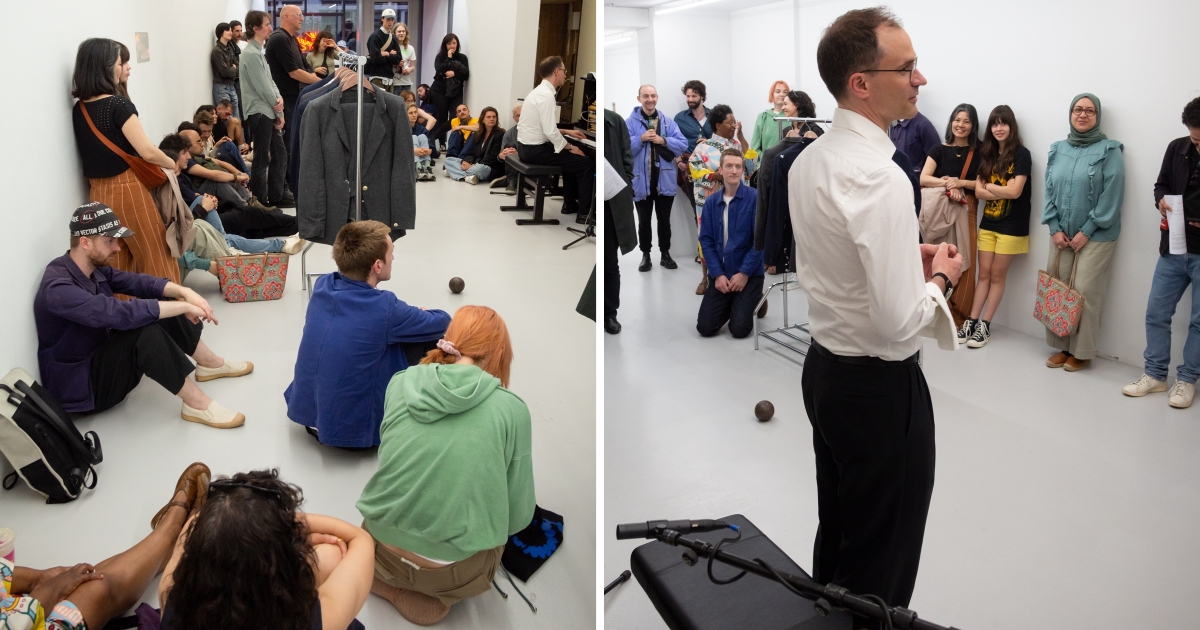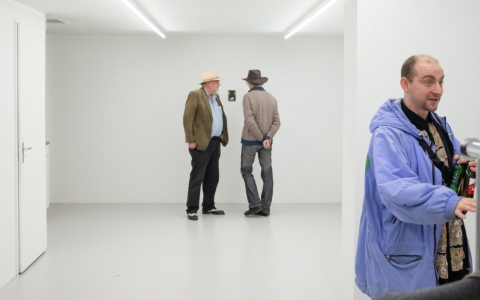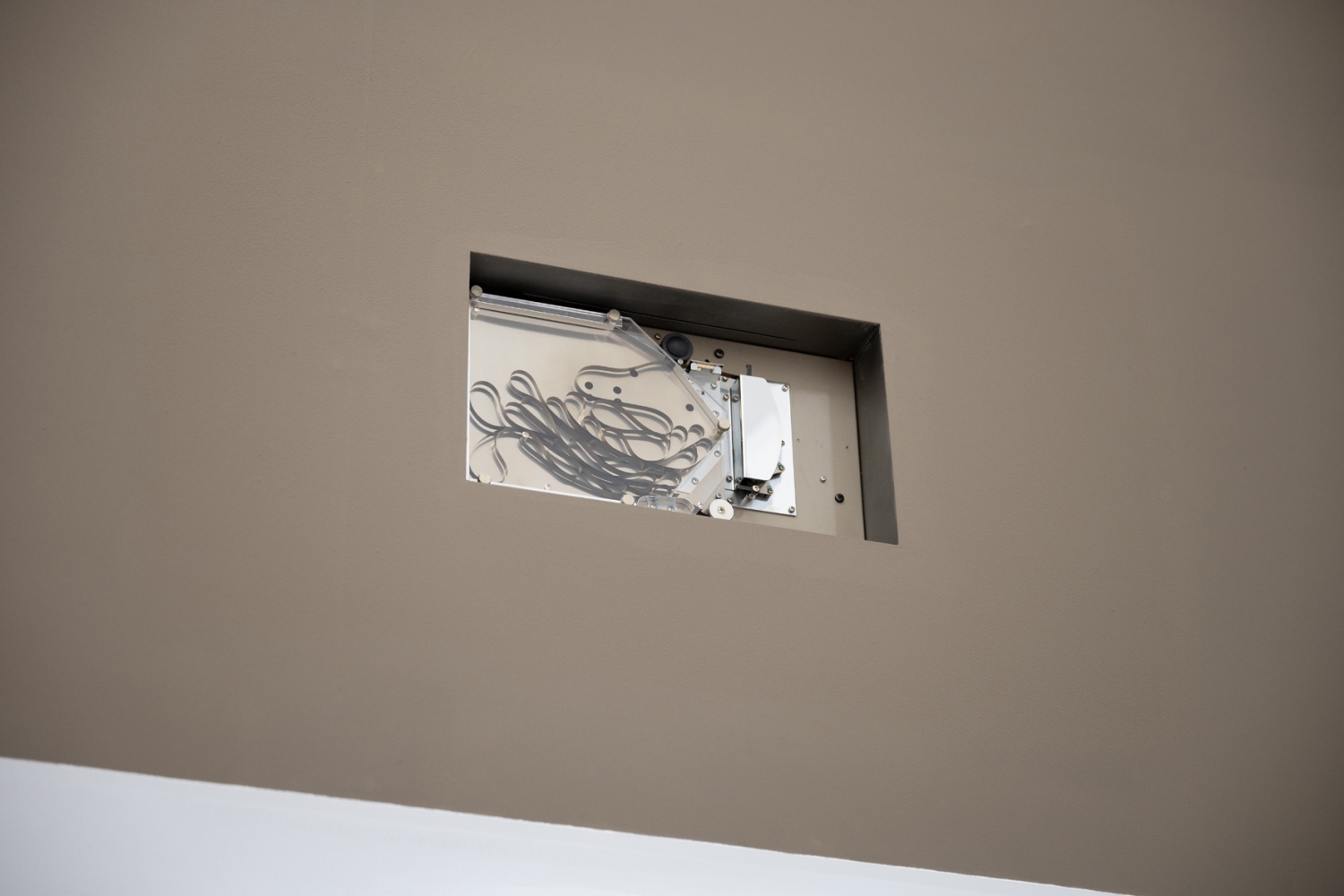Part 2: Errors
11.05.2024


Exhibition opening Volume III Part 2: Errors, May 2024. Photos: Job Willems


Exhibition view Volume III Part 2: Errors, May 2024. Photo: Lotte Stekeleburg


gerlach en koop, En om vier uur? Slapen., 2024. Photos: Lotte Stekeleburg


Exhibition opening Volume III Part 2: Errors, May 2024. Photo: Job Willems


Lisa Ivory, Foal Phantom (left), Hard Times (center), Call It Something Nice (right). All 2023. Photos: Lotte Stekelenburg


Exhibition opening Volume III Part 2: Errors, May 2024. Photo: Job Willems
Exhibition Opening: 19:00
Performance by Tom Aldrich & Mathew Kneebone 21:00
With Volume III, Part 2: Errors, we enter the next stage of The Last Terminal: Reflections on the Coming Apocalypse.
In Volume III, we will be re-staging and re-formatting exhibitions and works from the past as ways to explore the possibilities of extracting new significance, a new inflection not to erase the pasts of the works but to enlarge and expand upon them as well and especially to place the reconfiguration of ideologies pertaining to aesthetic infrastructures, cultures, and mentalities at the center of Rib’s operation.
Piano Unplugged: Variation I
Mathew Kneebone & Tom Aldrich
Piano Unplugged: Variation I is a piano piece conceived by artist Mathew Kneebone and composed and performed by musician & composer Tom Aldrich.
The composition draws from Kneebone’s archive of musical improvisations performed and
posted online by people experiencing a blackout. These brief melodies vary in modality and complexity, from children’s recitals to elaborate jazz riffs. Taken collectively, they convey a
spontaneous form of cultural production born
as a direct response to disruption caused by infrastructural failure. The score for the performance arranges these improvised samples according to interpretive compositional systems from Karlheinz Stockhausen’s Klavierstücke series, Henry Cowell’s New Musical Resources, and Tom Aldrich’s intuitive play.
Piano Unplugged: Variation I is the first rendition in a series of acoustic musical works based on improvised music created during power failure.
Paintings
Lisa Ivory (2024–2025)
We have presented two paintings by the British artist Lisa Ivory titled Tourist In Your Town (2023) and Love And Communication (2023) in the first part of Volume III.
In Part 2: Errors we will reveal two new paintings as part of a two-year-long exhibition of her works at Rib consisting of eight parts totalling about sixteen paintings by the end of 2025. In the process a number of art historians with distinct specialisations in 18th and 19th century painting and unfamiliar with Ivory’s work will share their readings of her paintings.
Ivory’s paintings point to an evolving story with a seemingly clear narrative arc yet the stories do not easily yield to identifications and sympathies. They undermine our certainties about where we are in relation to what we are looking at. We are aware that showing only a small portion of her works in each exhibition might form a challenge to a contemporary visitor, however, we want to see if time-stretching her exhibition across such a relatively long period might better reveal her painterly progression and at the same time allow space for them to resonate with works by other artists.
They lead one into a painterly universe; a shadow world, a natural habitat for nudes, skeletons, and domesticated monsters.
En om vier uur?
Slapen.
gerlach en koop (2024–ongoing)
In Part 1: Beating Death With His Own Arm Rib began with re-staging a solo exhibition by the artist collective gerlach en koop titled Was machen Sie um zwei? Ich schlafe. (GAK, Gesellschaft für Aktuelle Kunst Bremen, Germany, 2020). In this exhibition at the edge of sleep the collective displayed works by other artists. Over the course of the coming year, this solo exhibition will be re-staged at Rib. One work, two, maybe three at a time. Not all works on view in Bremen will be on view in Rotterdam however and the very act of re-staging the ones that are, will influence their presence.
gerlach en koop started their re-staging by inviting artist Tomo Savić-Gecan to present Untitled 2020/2022/2024, a work perhaps best described as an object representing a functional wall. The wall is now leaving us. The wall’s departure is a necessary gesture preserving its status as a work of art and highlighting the importance of duration against time’s ability to absorb and conceal even the most authentic of objects into a given infrastructure. Savić-Gecan’s wall could only be experienced through a physical encounter. For decades Savić-Gecan consistently has avoided the visual documentation of his works all of which are titled Untitled.
Sleeping can neither be learnt nor mastered. Sleep is a fickle force that cannot be forced. Sleep is granted. All one can do is imitate a sleeping body as best one can. To re-stage the night before and the night before and the night before hoping that at some point posture and breathing will match and the copy will again be convincing enough to merge with the original … and that is when you fall.
Anticipating that the three-centimetre void in Rotterdam—reminiscent of the three-centimetre void in Bremen—would dissolve into thin air soon, we asked Daniel Gustav Cramer to send the object that isn’t a work of art when seen in broad daylight. Details are disappearing from Alex Farrar’s suit, a new addition to the exhibition. The silent abyss of Laurent Montaron’s Melancholia will be rebuilt to once again be the exhibition’s ‘onrust’. Emilio Prini’s confirmation to participate remains in suspension. These works together shape Om vier uur? Slapen.
—gerlach en koop
Alex Farrar
In 2007—without any prior experience or technical advice—Alex Farrar made a suit from scratch to wear whenever representing himself as an artist. When it needed replacing he made a new one. After five ‘suits’ Farrar was able to make a suit that was indistinguishable from a professionally crafted one, and that concluded the project. This last suit is not on display, nor will it ever be. It is not an artwork. The artist keeps it the way one usually stores their best suit, in a garment bag, hanging in a wardrobe, but he will not wear it.
An exercise for insomniacs: imagine a room and then slowly strip it of everything inside. The objects, every little thing, the furniture, then continue with the windows, the doors, the skirting boards. Then remove all colour and the corners with their shadows until a completely white space remains. No details. No dimensions. A cloud-like nothing. Now your thoughts will have difficulty finding anything—a damp spot, a half-finished drill hole, a collapsed cobweb—to attach to and thus keep you from sleeping.
The first ‘suits’ were not only ill-fitting, they also showed all sorts of striking details, odd seams, unusual stitching … details that stood out. Ten years were used by the artist to gradually eliminate them. The ‘suits’ attracted less and less consternation in the public. If his suit is desire materialised, as Laura van Grinsven writes in her text about the work1, after the sixth one the desire became weightless. We imagine the artist standing in front of his wardrobe, staring at the garment bag.
Laurent Montaron
Endlessly undulating magnetic tape inside a machine from which the lid has been removed. It’s a Roland RE-201 or Space Echo, a machine that musicians use to add an artificial echo to their instruments. It was the first of its kind in the 1970s but is still popular today, despite digital alternatives. Two different kinds had been invented at the time; one artificially reproduced the acoustics of space to create reverberation, or ‘reverb’. The other artificially reproduced the acoustics of a canyon, an abyss, returning the sound as an echo. The Roland belongs to this last type, carrying in its interior an artificial canyon. The properties of this canyon can be adjusted with all kinds of controls, which brought to mind the shallow abyss described by Polish poet Zbigniew Herbert—the one that follows him everywhere he goes, clingy like a dog, not deep enough to swallow a head, a body, legs or even feet. The one that has yet to mature, to grow up, to become serious.2
The echo effect was achieved by laying down a recorded sound on magnetic tape, which was then looped and read in succession by a series of juxtaposed tape heads. As the tape came back to the start of its loop, the sound was silenced by a final tape head that erased the recording.
The Roland RE-201 has no output as it is not connected to a loudspeaker—not that it would make any difference, because there is no input. We don’t hear anything. All we can do is look at it, mesmerised, hypnotised, sleeping.
Emilio Prini
‘Confirm participation in the exhibition.’ A telegram sent to Kunstmuseum Luzern in 1970 as the artist’s contribution to the exhibition Visualisierte Denkprozesse [Visualised Thought Processes], probably his first use of a statement that Emilio Prini used again and again, always in slightly different formulations and iterations. Like the one typed on A4 paper—a standard—using an Olivetti 22 typewriter, one used as the cover for a book with Germano Celant (a book that was never made). All versions backed—and evidently so—by Prini’s presence in the world. That has changed since 2016. His death has put the work in a state of suspension, it has become a kind of testimony. Omaggio a Emilio Prini [Homage to Emilio Prini].
Wait a minute. The window’s rattling. ‘Se è pos-sible, non creo.’ If possible, I create nothing. Previous works have been repeated in Prini’s exhibitions, but never in the same way. These alterations were motivated by the new situation with which he found himself confronted. He introduced a certain limited number of ideas and works to the world that he constantly revisited, re-developed, re-framed or elaborated upon, keeping them in flux almost as if they were living material. At times he just revised a date, changed a title, or isolated a detail of an image. He might photograph a work as a replacement for the real object, or make a copy (and throw away the original).3 Describing Prini’s work in terms of material, technique and dimensions always requires a lot of question marks. Their main dimension is time.
- 1Laura van Grinsven, ‘Release me from this thing’, in: Alex Farrar, the ‘suits’ archived, with an inventory for ten years of performativity (Amsterdam: 7.45 Books, 2016)
- 2See the poem ‘The Abyss of Mr. Cogito’ in: Zbigniew Herbert, The Collected Poems: 1956–1998, trans. and ed. Alissa Vallies (New York: HarperCollins, 2008).
- 3In Rotterdam gerlach en koop display just the glass that in Bremen protected the actual stamp print on cardboard from the Archivo Emilio Prini in Turin, Italy.
Amsterdam-based composer/keyboardist Tom Aldrich has worked in jazz, rock, and modern classical music contexts. His musical sensibility is influenced by the Downtown NYC music scene of the 90s and early 2000s, where he established himself as an accordionist in the experimental jazz group the Four Bags. After moving to the Netherlands in 2006, he earned a master’s degree in composition from the Royal Conservatory in the Hague, composing pieces for Dutch new music groups such as Rosa Ensemble, Ensemble Klang, and the ASKO Ensemble, as well as the Bang on a Can Allstars (US). Aldrich’s recorded work runs a gamut from tightly composed, jazz-tinged instrumental rock (Princes, 2016) to introspective acoustic work (Solo Piano and Solo Piano 2, 2017/2021) and atmospheric electronic pieces (Elisions, 2021). In 2019 he formed the group Zolder Ellipsis as a vehicle for his music. The group’s debut album Entropy Override was released by Lizard Records in 2022, being described as ‘a wild mix of jazz-rock, quirky sounds, free improvisation and structured progressive rock’ (Progressive Rock Central). Their second album Book of Tropes will be released in 2024.
Daniel Gustav Cramer (b. 1975, Neuss, Germany) lives and works in Berlin. His works are created as an ongoing research, like a travel diary that attempts to describe the human condition, they draw their imagery from collective experiences and shared memories. Cramer archives collections, documents elusive apparitions, and captures seemingly ordinary moments of daily life. His fragmentary use of images and language incorporates references to conceptual and literary artistic strategies. Each photograph, archive, text and sculpture holds a faint story. Consequently, the exhibitions can be perceived as intertwined spatial narratives. In this working process, he delves into philosophical questions about the experience of time, the emergence of language and images, and the limits of perception. Solo exhibitions include Musée d’Art et d’Archéologie d’Aurillac (FR), Kunsthalle Mulhouse (FR), Kunsthalle Lissabon (PT), Kunsthaus Glarus (CH), Documentahalle, Kassel (DE), Kunstverein Nürnberg (DE), Salts, Biersfelden (CH), Tongewölbe t25, Ingolstadt (DE), Hara Museum of Contemporary Art, Tokyo (JP). CAC Contemporary Art Centre, Vilnius (LT). His work has been shown in group exhibitions including Manifesta 14, Pristina (XK), dOCUMENTA(13), Kassel (DE); Artists Space, New York (USA); Cura, Rome (IT); Museu Coleção Berardo, Lisbon (PT); NMNM Monaco (MO); Palais de Tokyo, Paris (FR); Piano Nobile, Geneva (CH); Witte de With, Rotterdam (NL); IAC FRAC, Villeurbanne (FR); Misk Art Center, Riyadh (KSA); Frankfurter Kunstverein, Frankfurt (DE); Mudam, Luxemburg (LU); and Renaissance Society, Chicago (USA).
Alex Farrar (b. 1986) is an artist based in Amsterdam, originally from West Yorkshire in the North of England. He studied at Leeds College of Art, Leeds Metropolitan University, Gerrit Rietveld Academie, Amsterdam, before completing a research fellowship at the Rijksakademie van Beeldende Kunsten, Amsterdam in 2016. His work explores the artistic use of the exhibition as a shared space between imagination and reality. Through considered groupings of individual works, Farrar encourages lyrical narratives to emerge, creating spaces to consider the intimate, feelingful ways in which we embody interrelated social, political, environmental and economic realities. He explores making processes, ranging from metal casting to embroidery, through complex relationship with form and content, often drawing directly from the ‘nervous body’ and involuntary expressions such as sweating, trembling and nail biting. Recent projects have been produced using participatory sense-making as a collaborative, open ended strategy for approaching the exhibition as an experimental civic space. As an extension of his exhibition-based practice he has self-published artists’ books under the imprint 7.45 Books, as well as working with Jap Sam Books on Notes on Happiness and Antonis Pittas’ jaune, geel, gelb, yellow. Monochrome.
Collective artist gerlach en koop works in twofold to invite a third. They live and work in The Hague, NL and Brussels, BE. Solo exhibitions include GAK Bremen, DE; Bonnefantenmuseum, Maastricht, NL; de Appel, Amsterdam, NL; Temporary Gallery, Cologne, DE; Alte Fabrik, Rapperswil-Jona, CH; 1646, The Hague, NL; Kröller-Müller Museum, Otterlo, NL; Library Van Abbemuseum, Eindhoven, NL; Stroom, The Hague, NL. Their work has been part of group exhibitions at the Project Arts Centre, Dublin, IE; La Criée, Rennes, FR; FIAC, Jardin des Tuileries, Paris, FR; de Appel, Amsterdam, NL; Mu.ZEE, Oostende, BE; de Vleeshal, Middelburg, NL; Netwerk, Aalst, BE; Le Grand Café, Saint-Nazaire, FR; Stroom, The Hague, NL; A Tale of A Tub, Rotterdam, NL; Lesage, Brussels, BE; S.M.A.K, Ghent, BE; the Baltic Triennial at CAC Vilnius, LT and Bunkier Sztuki, Kraków, PL; and Hammer Museum, Los Angeles, USA.
Lisa Ivory lives and works in London. Solo exhibitions include Beasts Beguiled, Museum of Witchcraft and Magic (Cornwall), Savage Gardens, Pamela Salisbury Gallery, New York, Vice, Malice, Lust and Cunning, Lubomirov-Angus-Hughes Gallery, London. Her work has been part of group exhibitions in London and overseas that include Ricco Maresca Gallery (New York), The London Art Fair (London), Charlie Smith (London), Saatchi Gallery (London), Fragment Gallery (Moscow) and Fabian Lang Gallery (Zurich).
Mathew Kneebone’s practice is founded on research into uncertainties surrounding technology, often combining different histories, myths, and folklore. His work touches upon various media including drawing, electronics, writing, sound, and performance to reconfigure or re-contextualize certain technologies, exploring an ambivalent blend of past and present. His work has recently been exhibited at Kunstverein, Amsterdam; 019, Ghent; Extra City, Antwerp; and Cloaca Projects, San Francisco. His writing has been published in Trigger Magazine, OASE Journal for Architecture, The Bulletins of The Serving Library, Another World, Umwelten, among others. He has given talks and workshops at Minnesota Street Project, San Francisco; V2_ Lab for Unstable Media, Rotterdam; Central Saint Martins, London; Sandberg Instituut, Amsterdam; San Serriffe, Amsterdam; Sitterwerk, St. Gallen; EKA Gallery, Tallinn; UEL, London. Kneebone teaches at California College of The Arts, San Francisco, where he is thesis writing supervisor.
Laurent Montaron (b. 1972) lives and works in Paris. He is an interdisciplinary artist working across film, photography, installation, sound and performance. His works draw from the history of technology to examine systems of belief, investigating the ways in which innovations have continually given rise to new ways of observing and understanding the world. Through his critical invistigations of the media and tools that shape our representations, his work lays bare the paradoxes that accompany our awareness of modernity. He has participated in numerous exhibitions internationally including EPPUR SI MUOVE, MUDAM, Luxembourg, 2015; You imagine what you desire, 19th Biennale of Sydney, 2014; The Encyclopedic Palace, 55th Venice Biennale, 2013; Open End-Goetz Collection, Haus der Kunst, Munich; Lost in LA, Los Angeles Municipal Art Gallery, Barnsdall Art Park, Los Angeles, all 2012. Recent key solo exhibitions include To Tell a Story, Les Rencontres d’Arles, 2024; Gallery Monitor, Lisbon, 2020; ECCE, Biasa ArtSpace, Ubud, Bali, 2019; REPLICA, CCA, Tel-Aviv; Les Moulins de Paillard/Centre d’Art Contemporain, Poncé sur le Loir; télé-vision, Galerie Anne-Sarah Benichou, Paris, all 2018; Diorama, Fondation d’ Entreprise Ricard, Paris, 2016–2017; Everything is accidental, Mercer Union, Toronto; Le origini del film, Palazzo Grassi | François Pinault Foundation, Venice; Everything we see could be something else, Monitor, Rome, all 2014; Prospectif Cinema: Laurent Montaron, Centre Pompidou, Paris, 2013; Laurent Montaron, Pigna Project Space, Rome, 2013; Laurent Montaron, galerie schleicher+lange, Berlin 2012; and Pace, Kunsthaus Baselland, Basel, 2010.




















